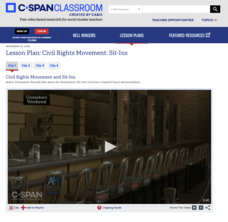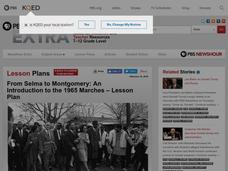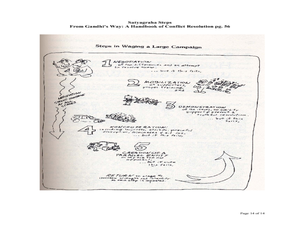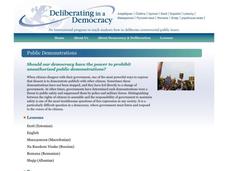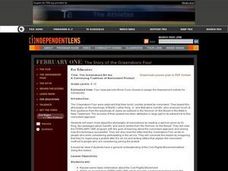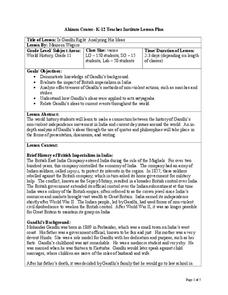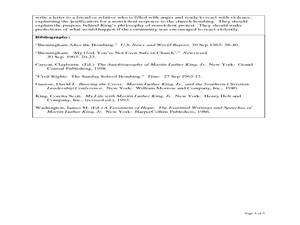Curated OER
Speaking Out Against War
High schoolers research on the Web and in other venues to track the Iraq war protests high school students have joined or even led. High schoolers interview students in your community who have joined protests or expressed their views in...
Curated OER
Gandhi's Voice: Writing as Nonviolent Resistance
Ninth graders identify how Mahatma Gandhi used writing as a means of nonviolent communication. In this nonviolent resistance lesson, 9th graders watch a film about Gandhi as a writer and identify characteristics of nonviolent activism....
C-SPAN
Civil Rights Movement: Sit-Ins
Part of the protests of the Civil Rights Movement were small scale sit-ins at lunch counters. This form of on-the-ground activism is the focus of a C-SPAN resource that includes four video-clips about the sit-ins by pupils at a lunch...
PBS
From Selma to Montgomery: An Introduction to the 1965 Marches
The 1965 Civil Rights marches from Selma to Montgomery and the resulting Voting Rights Act of 1965 are the focus of a social studies lesson. The resource uses film clips to inform viewers not only about the discrimination that gave rise...
K20 LEARN
Power To The People: Bill Of Rights Art
The works of Juane Quick-to-see Smith are featured in a instructional activity that asks pupils to consider the role artists play in bringing about social and political change. Scholars examine protest art by Smith and several street...
Curated OER
Gandhi's Non-violent Revolutions: Examining Tools to Make Non-violent
Students analyze Gandhi's philosophy of nonviolent social change. In this nonviolence and social change lesson, students research a leader from the attached list who practiced nonviolent social change. Students write their own poem...
Curated OER
Socratic Seminar on Martin Luther King, Jr.’s Letter From Birmingham Jail
Key in the struggle to gain the rights of democratic citizenship was the April 1963 arrest of Dr. Martin Luther King, Jr. for civil disobedience. To deepen their knowledge and understanding of events during the civil rights movement,...
Curated OER
Paradigm Shift: Gandhian Nonviolence and the Concept of Power
Learners interpret historical evidence presented in primary and secondary resources. In this social justice lesson, students examine sources regarding the teachings of Mohandas Gandhi pertaining to nonviolent...
Deliberating in a Democracy
Public Demonstrations
Have you ever fought publicly for an idea you believe in? Scholars research and analyze the right to demonstrate peacefully. Incorporating different real-life scenarios as well as legal decisions exposes the concept of democracy and free...
Curated OER
Nonviolent Protest Around the World
Twelfth graders complete research that exposes them to examples of nonviolent protest throughout the modern world. In this nonviolent protest research lesson, 12th graders discover information about signification nonviolent movements...
Curated OER
The Greensboro Sit-Ins: A Continuing Tradition of Nonviolent Protest
Students watch a video about nonviolent protests during the Civil Rights Movement. They discuss and write about the Greensboro sit-ins while deciding the effectiveness of this type of protest.
Curated OER
Is Gandhi Right: Analyzing His Ideas
Students explore the connection between Gandhi and the Independence Movement in India. For this lesson on social change, students examine the ideas of Gandhi to analyze non violent change. Students consider the impact of British...
University of North Carolina
Sitting Down To Stand Up For Democracy
Boycotts and bus rides, sit-ins and speeches. The focus of this amazing resource is on those people who were willing to put themselves at risk to take a stand for their belief in equal rights for all. A must-have for your curriculum...
PBS
Martin Luther King Jr.: Civil Rights Leader
Expand class members' appreciation of the work of Dr. Martin Luther King, Jr. A powerful resource examines King's speeches, writings, and actions that reveal his deep commitment to a nonviolent approach to Civil Rights. Learners watch a...
Curated OER
Selfless Service and The Giving Tree - Building Ethical Conscience
Upper elementary schoolers investigate philanthropy and selflessness by reading a children's book. In this ethics lesson, they read The Giving Tree by Shel Silverstein, and research Mahatma Gandhi's troublesome, yet inspiring, life....
Atlanta History Center
Civil Disobedience and the Atlanta Student Movement
What tactics are used in civil disobedience? Learners study the conditions in Alabama that led to the establishment of the Atlanta Student Movement, as well as consider the nature and effectiveness of civil disobedience.
Curated OER
Dr. King’s Leadership in the Aftermath of the Bombing of Birmingham’s Sixteenth Street Baptist Church
Students explore the concept of nonviolent resistance. In this nonviolent resistance instructional activity, students consider how Dr. King led during the aftermath of the bombing of Birmingham's Sixteenth Street Baptist Church.
Curated OER
Youth Participation in Nonviolence
Students explore the use of nonviolent resistance. In this social justice lesson plan, students listen to their instructor present a lecture on Mohandas Gandhi and Martin Luther King, Jr. as well as the Apartheid Movement in South Africa.
Facing History and Ourselves
Eyes on the Prize Lesson 2: Six Steps for Nonviolent Social Change
Students explore the concept of nonviolent protest. For this Civil Rights lesson, students examine the attributes of nonviolent protest as they investigate the student protests that took place in Nashville in 1960-1961. Students reflect...
Curated OER
Nonviolence as a Tool for Change Lesson 2
Students explore nonviolent protest. In this Civil Rights instructional activity, students read the essay "Nonviolence and Racial Justice." Students present the information they gleaned from the essay to their classmates in order to...
Curated OER
A Comparison of Two Great Leaders: Mahatma Gandhi and Martin Luther King Jr.
Students explore these two leaders use of nonviolent protest techniques. They read about the life of King Jr. They view a slide show about the life of Gandhi. Compare/contrast the lives of these two men using a Venn diagram.
Stanford University
Lesson Plan: The Children's Crusade and the Role of Youth in the African American Freedom Struggle
Young people played significant roles in the Civil Rights movement. Class members examine the contributions of Barbara Johns, Claudette Colvin, Mary Louise Smith, and the children of Birmingham,...
Curated OER
The Importance of Self-Governance in Changing Laws
High schoolers examine the teachings of Gandhi and King. In this nonviolent resistance instructional activity, students listen to a lecture that reveals how Gandhi and King educated their followers about nonviolent resistance. High...
Curated OER
Can Forgiveness Lead to Nonviolence?
Tenth graders determine if forgiveness can lead to nonviolence. In this nonviolent resistance lesson, 10th graders discuss the concept of forgiveness and read examples of the forgiveness that Gandhi granted. Students write letters of...




